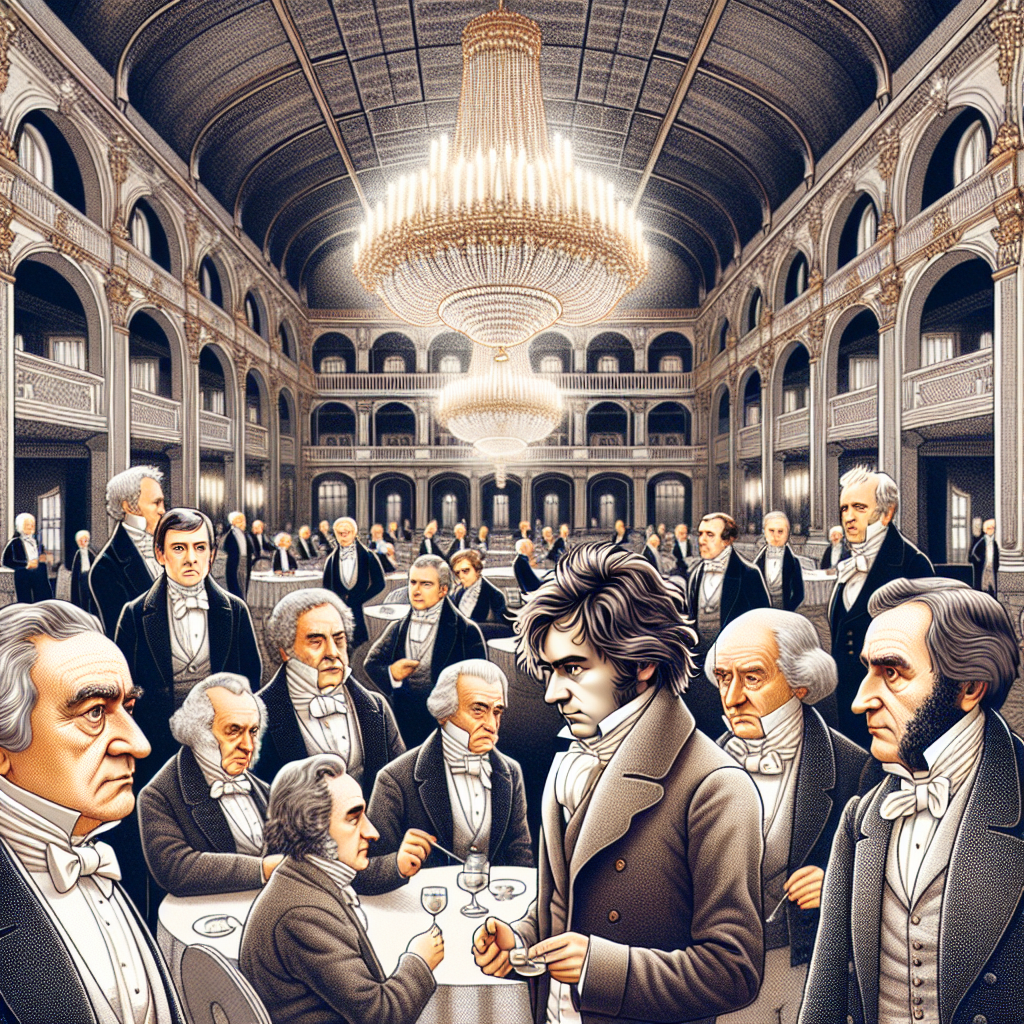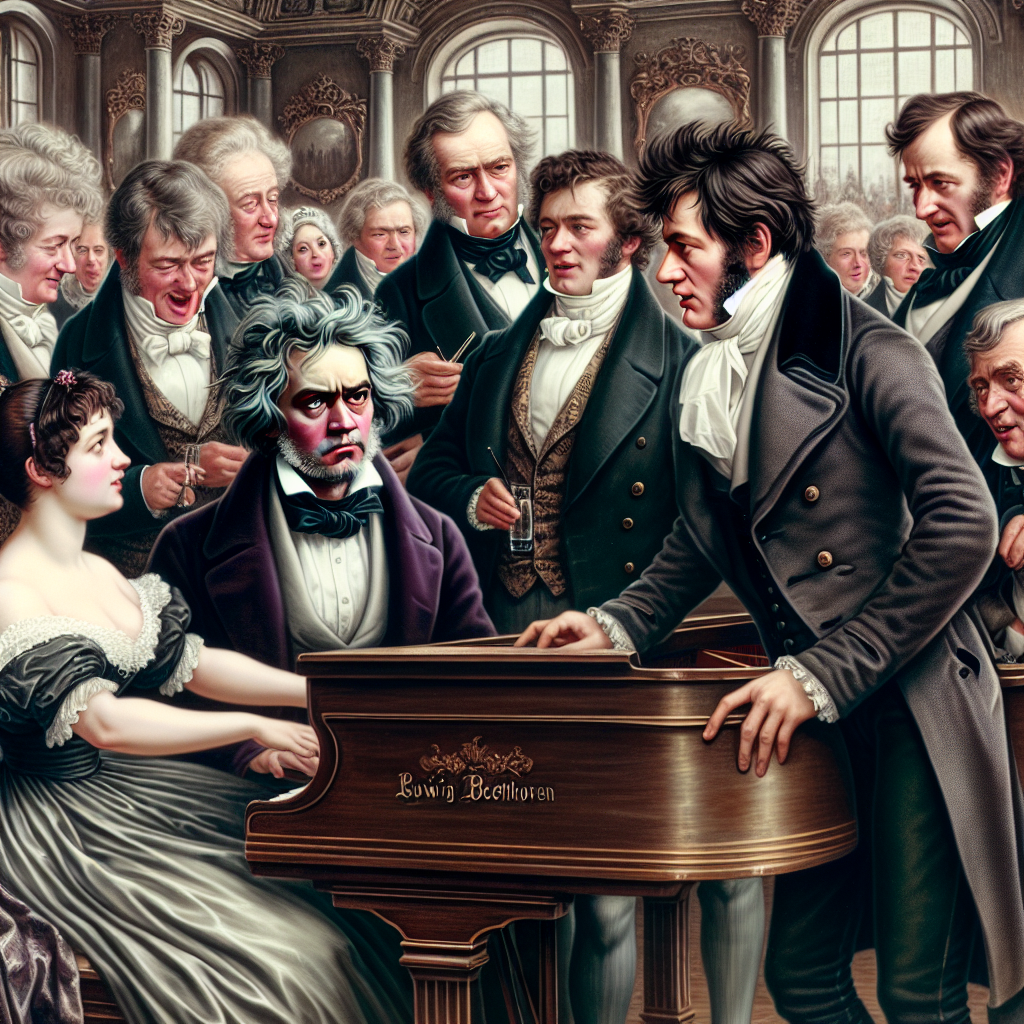
Beethoven’s Connections with Viennese Aristocracy
Ludwig van Beethoven, born in December 1770, is universally acknowledged as one of the greatest composers in the history of Western music. A pivotal figure during the transition from the Classical to the Romantic era, Beethoven left an indelible mark on the music world, both in his time and for generations to come. His compositions, ranging from the magnificence of his symphonies to the intimate vulnerability of his piano sonatas, have transcended time and space, influencing innumerable artists and music lovers. However, Beethoven’s rich musical legacy was shaped not only by his immense talent but also by his complex relationships with the people around him. Among the most influential were his connections with other artists and patrons, especially the Viennese Aristocracy. Vienna, the cultural heart of Europe during Beethoven’s time, was a magnet for musical talents and patrons eager to foster artistic brilliance. This aristocratic support was crucial for Beethoven, as it provided him not only with financial stability but also with opportunities to network, collaborate, and be inspired. In exploring Beethoven’s life and history, it is essential to delve into these significant relationships—how they began, the roles they played in his career, and the impact they had on his personal and professional life. By doing so, we gain a fuller understanding of the man behind the music and the societal framework that supported his genius.
Beethoven and the Archduke Rudolph
One of Beethoven’s most important and enduring relationships with the Viennese aristocracy was his bond with Archduke Rudolph of Austria. Archduke Rudolph was not just a royal patron but also an ardent admirer of Beethoven’s work and, notably, his pupil. Their relationship began when Rudolph became Beethoven’s student in 1803 and continued to grow both professionally and personally over the years. Rudolph was a keen amateur pianist and composer, which made him not just a benefactor, but a kindred spirit who deeply appreciated the nuances of Beethoven’s art. This mutual respect and admiration fostered a strong bond between the two. Beethoven dedicated several major works to Rudolph, including the Piano Trio in B-flat major, Op. 97 (commonly known as the “Archduke Trio”), and Missa Solemnis, Op. 123. The Archduke’s patronage had a significant impact on Beethoven’s life and career. Unlike other patrons who often dictated the terms of their commissions, Rudolph provided Beethoven with a rare sense of artistic freedom. This allowed Beethoven to explore his creative impulses without the constraints typically imposed by financial necessity or the whims of less understanding benefactors. Moreover, the association with the Archduke also conferred a level of prestige and status that was beneficial for Beethoven’s career. The Archduke’s endorsement was a powerful testament to Beethoven’s talents, opening doors to other aristocratic circles and enhancing his reputation within Vienna’s elite.
Beethoven and Prince Lichnowsky
Another significant relationship in Beethoven’s life was with Prince Karl Alois Lichnowsky, a well-known patron of the arts. Lichnowsky was an avid supporter of the musical arts and a personal friend of Mozart before extending his patronage to Beethoven. Their relationship began shortly after Beethoven moved to Vienna in 1792, and Lichnowsky quickly became one of his foremost patrons and supporters. Lichnowsky provided Beethoven with financial support, including annual payments, a place to stay, and the reassurance of a steady income, which allowed the composer to focus more on his work without the distraction of financial insecurity. Beethoven dedicated several works to Lichnowsky, including the Piano Sonatas Op. 13 (the “Pathétique”) and Op. 27, and the Symphony No. 1 in C major, Op. 21. However, the relationship between Beethoven and Lichnowsky was not without its strains and tensions. Lichnowsky, like many patrons of his time, might have had expectations on how Beethoven should compose or perform. In 1806, a significant conflict arose when Lichnowsky demanded that Beethoven perform for French officers during the occupation of Vienna. Beethoven refused and, in a fit of rage, reportedly smashed a bust of Lichnowsky. Despite these confrontations, the support Beethoven received from Lichnowsky was undeniably significant. It provided Beethoven with the resources and the platform to develop his early career, fostering an environment where he could produce some of his most renowned early works.

Beethoven and Count Razumovsky
Count Andreas Razumovsky, a Russian envoy to Vienna, was another influential patron in Beethoven’s life. Razumovsky was a great lover of music and a skilled violinist himself. His passion for the arts and his wealth made him an ideal supporter of Beethoven’s ambitious projects. Razumovsky commissioned from Beethoven a series of string quartets, which would later be known as the “Razumovsky” quartets, Op. 59. These compositions marked a significant development in Beethoven’s style, showcasing his growing boldness in exploring complex structures and deeper emotional expressions. The quartets were dedicated to Razumovsky and premiered in his grand palace in Vienna, often cited as pivotal works in the history of string quartet literature. Beyond financial support, Razumovsky’s patronage offered Beethoven a social platform within the elite circles of Vienna. Razumovsky’s soirées were attended by the crème de la crème of Viennese society, giving Beethoven greater visibility and access to potential patrons and supporters. The relationship between the two men, though primarily professional, was mutually beneficial. Beethoven’s works elevated Razumovsky’s standing among high society, portraying him as a cultured and enlightened patron. Meanwhile, the financial and social backing Beethoven received allowed him to reach new creative heights, yielding works that would solidify his reputation.
Beethoven’s Friendships with Fellow Composers
While Beethoven’s connections with aristocratic patrons were crucial, his relationships with fellow composers and musicians also played a vital role in his life and work. One noteworthy friendship was with Franz Joseph Haydn, who was one of Beethoven’s early mentors. Although their relationship had its tensions, Haydn’s influence on Beethoven’s formative years in Vienna was undeniable. Haydn provided Beethoven with invaluable guidance in composition, steering his early works and helping him refine his unique style. Another prominent relationship was with Johann Nepomuk Hummel, a well-regarded pianist and composer of the time. Though their friendship was sometimes marked by rivalry, it was also characterized by mutual respect. They often exchanged ideas and musical influences, and Hummel’s more ornamented style subtly impacted some of Beethoven’s compositions. Beethoven’s friendship with Ferdinand Ries, his student and lifelong friend, also stands out. Ries not only supported Beethoven emotionally but also helped in promoting his work. Ries’s memoirs are invaluable historical documents that provide insights into Beethoven’s life and personality, enriching our understanding of the great composer. These relationships with fellow artists created a network of mutual influence and support, crucial for Beethoven’s artistic development. The exchanges, whether cooperative or competitive, pushed Beethoven to explore new territory and continue evolving as a composer.
The Immortal Beloved: Beethoven’s Romantic Entanglements
Beethoven’s personal relationships were often as tumultuous and intense as his music. Among these, his romantic entanglements have intrigued historians and music lovers alike. At the heart of these mysteries is Beethoven’s “Immortal Beloved.” The identity of this woman has been the subject of speculation for centuries, particularly after the discovery of an unsent letter addressed to her. One of the most likely candidates is Antonie Brentano, a Viennese aristocrat. Their emotional bond and intellectual connection were profound, but societal norms and differences in their social standings presented insurmountable barriers to their union. Another prominent figure is Countess Giulietta Guicciardi, a young student of Beethoven to whom he dedicated the famous “Moonlight Sonata.” However, this relationship, too, was short-lived, as societal class constraints and family opposition played spoilsport. These romantic entanglements deeply influenced Beethoven’s emotional state and, consequently, his music. His intense feelings, whether of unrequited love or passionate affection, found expression in the lyrical, tender movements of his sonatas and the soaring, impassioned melodies of his symphonies. Beethoven’s romantic experiences, filled with longing, despair, and occasional joy, added a layer of personal depth to his compositions, making his music resonate with universality and human complexity.
Conclusion
Ludwig van Beethoven’s illustrious career and enduring legacy were profoundly shaped by his relationships with other artists, patrons, and the Viennese Aristocracy. These connections provided the necessary financial support, emotional backing, and creative stimulation that fostered his artistic genius. Through bonds with patrons like Archduke Rudolph, Prince Lichnowsky, and Count Razumovsky, Beethoven found the stability and encouragement needed to explore the depths of his musical creativity. These aristocratic patrons not only appreciated his art but elevated his status within the elite social circles of Vienna, thereby enhancing his reputation and influence. Similarly, Beethoven’s friendships with fellow composers and musicians—be it his mentorship under Haydn or his camaraderie with Hummel and Ries—played a critical role in his artistic development. These relationships were as much about mutual influence and friendly rivalry as they were about support and inspiration. Moreover, Beethoven’s personal relationships, especially his romantic entanglements, added another layer of complexity to his life. The emotional richness and intensity of his music were often reflections of his own passionate, albeit turbulent, experiences. In sum, Beethoven’s connections with the people around him were as varied and intricate as his compositions. They shaped not only the trajectory of his career but also the very essence of his music. Through an understanding of these relationships, we gain a more comprehensive view of Beethoven—not just as a towering figure of Western music but as a human being, deeply enmeshed in the social and cultural milieu of his time. His life and legacy remind us that even the greatest geniuses are often sculpted by their relationships and experiences, making their achievements a testament to both individual talent and collective influence.